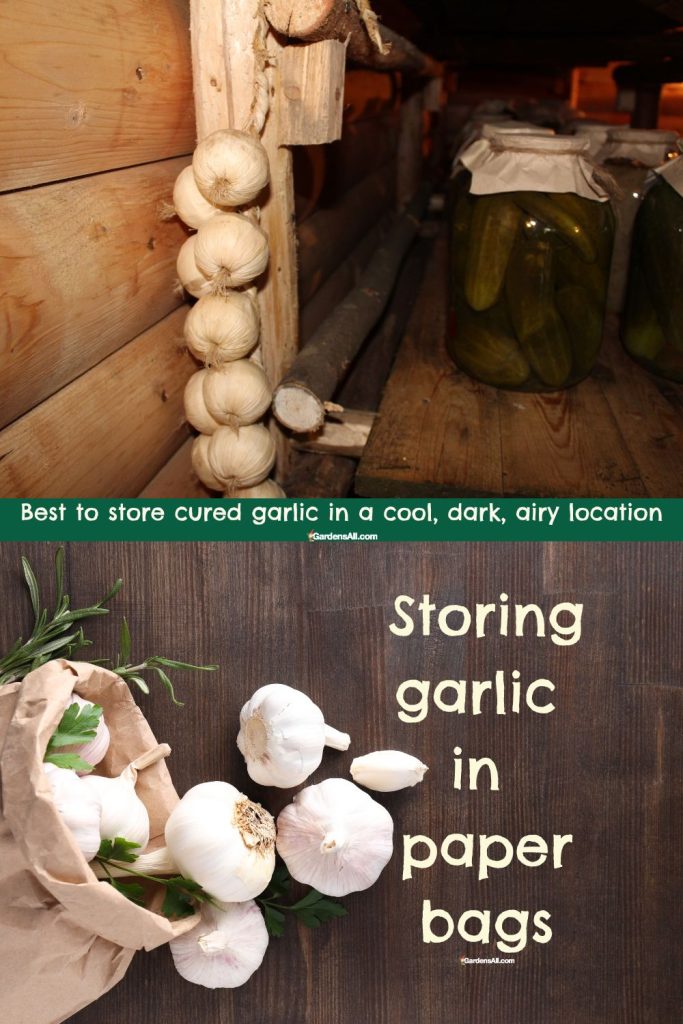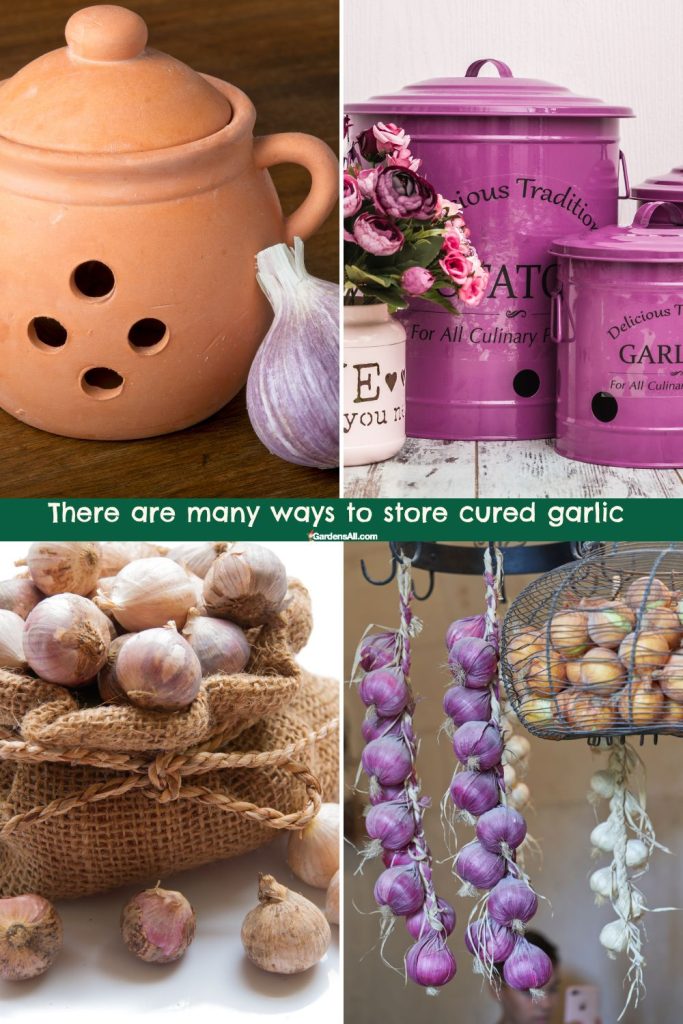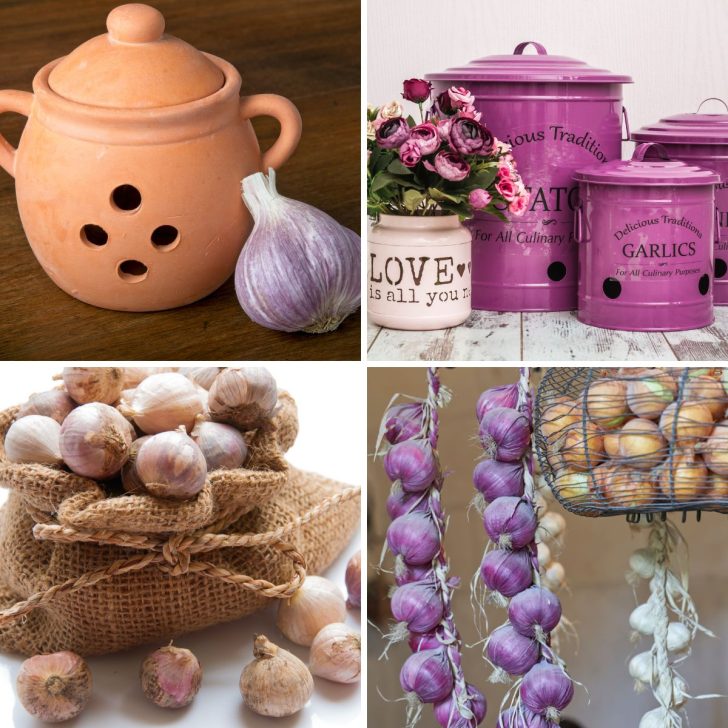It never occured to me to to wonder about how to store cured garlic until we started growing it. We just always kept it with the onions in a bin in the pantry. But growing garlic naturally led to learning more about it, how to cure it and then so many other questions as well, which we answer in our article on curing garlic.
If you’re growing your own garlic, it’s all the more important to know how to store garlic. You’ve spent time and money on the planting and nurturing of your crop, then harvesting it and curing the garlic. So next you’ll definitely want to know how to store garlic for longevity.
How to Store Cured Garlic
Storing cured garlic properly is important to ensure it maintains its flavor and longevity. Here are some general guidelines on how to store cured garlic:
- Room Temperature: Cured garlic should be stored in a cool, dry place, ideally between 60 and 70 degrees Fahrenheit. An ideal place could be a pantry or cupboard away from heat sources like the oven or direct sunlight.
- Air Circulation: Garlic needs air circulation to prevent mold growth. It’s not recommended to store garlic in sealed containers or plastic bags. Instead, use mesh bags, paper bags with holes, or baskets.
- Darkness: Exposure to light can cause garlic to sprout. Thus, it’s best stored in a dark place.
- Avoid Humidity: Too much moisture can lead to rotting. Avoid storing garlic in locations with high humidity like under the sink or in a refrigerator.
- Keep it Intact: Do not break the garlic head into individual cloves until you’re ready to use them, as the skin protects and preserves the garlic.
- Storing Chopped Garlic: If you have garlic that’s already been chopped or minced, it can be stored in the refrigerator for a short period of time. You can also freeze chopped garlic in small portions for later use.
- Freezing garlic: Can you freeze garlic! Yes! 😊
Remember, garlic’s longevity will depend on its variety. Softneck varieties can typically be stored for longer periods (6-8 months) than hardneck varieties (4-6 months). And always check your stored garlic before use; discard if it’s soft, discolored, moldy, or smells off.
Long Lasting Garlic Varieties
Softneck Garlic
Softneck varieties, which are typically found in supermarkets, tend to have a longer shelf life and can last up to a year under optimal conditions.
Hardneck Garlic
The hardneck varieties of garlic, usually last between six to eight months.
You can find lots more on different types of garlic to grow here.
Types of Garlic Storage Containers
There are so many cute and handy garlic storage containers. We love scanning through the many options. In fact, garlic storage containers make great gifts for gardeners who grow garlic as well. We love them all, but especially this beautiful handmade ceramic garlic keeper jar.
Here’s our list in alphabetical order.
BAGS AND SACKS
Burlap Sacks
Similar to mesh bags, burlap sacks allow for good air circulation. They can be used if you have a small or larger amount of garlic to store, for these come in all sizes, shapes and styles.
Pros
- CAPACITY: Can often storage larger quantities
- CLEANING: These can be machine washed; recommend on delicate cycle and air dry for longevity
- LIGHT: Opaque, so provides protection from sunlight.
- VENTILATION: Provides good ventilation.
Cons
- CAPACITY: Not practical for small quantities of garlic as they are generally larger bags.
- QUALITY CONTROL: The garlic might be less accessible and harder to see to monitor the freshness quotient.
Handwoven Jute Teardrop Hanging Storage Basket
Handwoven jute teardrop hanging storage baskets are an eco-friendly option to buy or to make if you crochet, that can also enhance the aesthetics of your kitchen or pantry. They work well for hanging garlic and other produce and can be bought or made in different sizes to accommodate the different sized produce.
TIP: If you’d like to make your own, you can buy crochet patterns for these on Etsy.
Pros
- ACCESSIBILITY: Can store a fair amount of garlic.
- ATTRACTIVE: Adds a decorative touch to your kitchen or pantry.
- COST: Not cheap but less if you make your own.
- ECO-FRIENDLY: Jute is a sustainable material.
- GIFTS: Make lovely gifts for gardeners and cooks.
- VENTILATION: Provides excellent ventilation due to the open weave.
Cons
- Garlic is exposed to light, which can encourage sprouting.
- Depending on the weave, smaller garlic cloves may fall out.
- Requires space for hanging.
- Might be more expensive than other options due to the handwoven nature.
Mesh Bags for Storing Garlic
Mesh bags offer excellent air circulation for storing garlic and can be hung which can help with storage space. Hanging storage, like vertical gardening, is a great way to make the most of limited space. We like that most mesh bags are also washable and so can last for awhile and be cleaned as needed.
Pros
- CAPACITY: These come in all sizes and can store small, large or medium amounts of garlic.
- CLEANING: Most mesh bags are capable of be machine washed many times over
- COST: Typically inexpensive
- SPACE: Mesh bags can hang, which can optimize storage space
- QUALITY CONTROL: Most of the mesh bags are see-through, which means that it’s easy to assess the state of freshness without opening and sorting through
- VENTILATION: Offers excellent airflow
Cons
- APPEARANCE: Some of these are non-descript so not necessarily the most attractive garlic storage container.
- LIGHT: Garlic is exposed to light, which can encourage sprouting, so if you prefer to go with garlic storage bags you might try burlap or cotton.
Paper Bags
A paper bag with some holes poked in a circle around the sides works fine as a garlic storage container. I like to roll the top down a couple turns to give it an easy opening. Where it sits in our pantry, there’s a solid shelf above it, so it’s basically still mostly protected from light and yet leaving the bag open at top also helps with ventilation.
Just remember to ask for paper at your local grocery store, and don’t be shy to ask them to bag somethings into smaller bags. For instance, if you’re buying wine, ask for the bottles to be bagged in the wine bottle bags.
You can always cut those down in size later. In fact, you can cut them in half and staple the bottom of the cut off top portion and get two garlic storage bags out of one wine bottle bag.
Similarly, you can also ask the bagger to use small bags to protect glass jars. Chances are they won’t mind and meanwhile, you’re getting several small sizes of paper sacks for free that are great for storing garlic.
Paper bags won’t last as long as any of the other options we’ve listed, but since they’re readily available and free, we’re not even going to add that bit to the con list.
TIP: Alternately, you can buy small bags with handles in all sizes as well. These mini bags can be great for bagging up for market sellers or garlic gifts to friends and family.
Pros
- ACCESSIBILITY: It’s relatively easy to shake the bag or rifle through the big to assess the state of the garlic and select which ones to use next.
- ART OPTION: So they’re not pretty, however, if you like to do art, you (and your kids if you have them), can draw and color designs, words, etc. on the bags.
- AVAILABILITY: Readily available for free.
- COST: It’s free!
- LIGHT: The opaque brown bag helps to block light which could lead to sprouting.
- STORAGE: Paper bags with handles can be hung to store and also sit well on a shelf.
Cons
- AESTHETICS: Of course these are probably your least attractive option, however, even that can be remedied, as indicated above!
- MOISTURE: Paper bags can absorb and hold moisture from the air, which can be imparted to the garlic and potentially cause molding or premature aging.
- STORAGE: Some paper bags may tend to fall over on the shelf, however are more stable if rolled open.

Baskets for Storing Garlic
Baskets are increasingly popular these days, and as with garlic keeper jars, there’s a plethora of options to choose from. You can scroll through page upon page of storage baskets of all sorts. You’ll see wire, wicker, wood, vines, or other breathable materials which are the best breathable options for storing garlic. And they come freestanding or in racks and stackable.
Storage baskets are good for air circulation, but the woven baskets are hard to clean. If you have any produce spoilage, your woven basket may never be the same. But for storing cured garlic spoilage isn’t as big a concern as it is with something like onions or potatoes.
Pros
- ACCESSIBILITY: Easy to access and monitor the condition of the garlic.
- ATTRACTIVE: Many baskets and basket systems are attractive, trendy, or thematic, and help bring order to your kitchen and storage places.
- COST: Low to medium cost, depending on the type of basket you choose
- VENTILATION: Allows good air circulation.
- VERSATILITY: These come in so many sizes, systems and materials
Cons
- CLEANING: Woven baskets can be hard to keep clean
- LIGHT: Exposure to light can promote sprouting and most baskets are wide open at top.
- SPACE: These can be bulkier and takes up counter or pantry space.
Here’s what we’ve been using for storing garlic: clear plastic storage bins. They’re great visibility for quality control, but that means they’re also wide open to light exposure. Fortunately, we don’t have windows in our pantry, so light exposure is minimum. However, we’ll be upgrading soon in order to extend the shelf life of our homegrown, fresh cured garlic!
Garlic Keeper
Garlic keepers are special containers designed specifically for storing garlic. They’re often made from materials like ceramic, terra cotta or tin. We recommend the ceramic or terracotta, which help regulate moisture. Most of garlic jars also usually feature holes for ventilation and a lid to keep out light.
Pros
- APPEARANCE: Many attractive styles, and adds a decorative flare to your kitchen
- CAPACITY: Comes in many sizes shapes
- CLEANING: Easy to clean, (and are often dishwasher safe)
- GIFTS: Makes great gifts for gardeners and cooks
- LIGHT: Most have lids to minimize light exposure
- LONGEVITY: These should last forever… (see cons below)
- HUMIDITY: Regulates moisture effectively due to its material
- VENTILATION: Includes aeration holes in lid, jar or both
Cons
- COST: Typically more expensive than other storage options.
- LONGEVITY: …so long as they’re not dropped and broken!😳😜
Glass Containers with Lids
Though not often recommended due to lack of ventilation, if you’re in a pinch, you can store garlic in a glass jar. Make sure to keep it in a cool, dark place and open the jar occasionally to allow for air circulation.
If possible, use a brown glass jar, which minimizes light exposure. You can even get them free when you buy things that come in them, such this boullion that we use. Activated yeast jars are also brown, and while typically only 4 ounces, they can be perfect for storing small amounts and easy enough to dump into your hand to sort through for using.
TIP: Punch holes into the lids of recycled glass jars to allow aeration. To punch holes, carefully tap an ice pick with a hammer into the top of a lid on a solid cutting board surface. Just be careful of touching the rough inside of the punches holes with your hand or the garlic so as not to mar either.
Pros
- ACCESSIBILITY: Easy to check the condition of the garlic.
- ATTRACTIVE: Not especially, but fine for pantry shelves
- COST: Free if using recycled jars.
- LONGEVITY: Long lasting, but also easy to replace for free.
- RECYCLING: Upcycles used jars to new good use for free.
Cons
- VENTILATION: Limited air circulation unless holes are punched into lids.
- LIGHT: Light can penetrate, promoting sprouting, (although dramatically less so using brown jars).
Hanging Racks or Strings
Garlic can be stored by braiding the stems together and hanging them in a dry place. Braided garlic is a popular way of hanging garlic to cure.
This works great to then store it in the same way as for drying the garlic, but with one possible difference: It’s best to hang store garlic in a cool dark room if available, rather than outside as some garlic is cured.
Pros
- ATTRACTIVE: Most braided garlic is attractive to see and can be made more so by braiding with or hanging with colorful peppers and/or herbs.
- COST: It’s free to braid garlic and with a little practice, it can be done quickly
- SELF CONTAINED: Cure and store garlic in this same way
- VENTILATION: Hanging in its essence of stem and stalks tends to keep garlic off surfaces, which reduces the chance of mold forming.
Cons
- LIGHT: The main issue here is that the garlic may be exposed to light. However, if your pantry doesn’t have a window, and the light is off when not in use then it won’t be exposed to much light anyway.
Remember, whatever storage method you choose, make sure your garlic is kept cool, dry, and out of direct sunlight to maintain its freshness and flavor.
In Summary
Proper storage is crucial to extend the life of cured garlic. It should be stored in a cool, dry place with good air circulation. A mesh bag, basket, or even a paper bag can work well for storage. It’s important to keep it out of the refrigerator, as the humidity can cause the bulbs to mold. Garlic should also be kept away from direct sunlight and extreme temperatures.
Keep in mind that individual cloves (aka lobes) will start to dry out once the bulb (aka head) is broken apart, so it’s best to keep the bulbs whole until you’re ready to use them.

I’m LeAura Alderson, a garden, herb and plant enthusiast with a passion for discovering the many edible and medicinal benefits of the plants all around us, including the weeds! I’m a writer, editor and media publisher for our family of websites.
While I was certified in fitness and life coaching, I am NOT a health practitioner. However, I’m a lifelong health enthusiast, with a keen interest in healthy, organic foods and making home remedies and the content we share is from our own experience and usage as well as that extracted from scientific research so that you can explore further on your own.
Always seek the advice and guidance of your health practitioners first and foremost.
As a family we’re steadily expanding our gardening, experimentation and knowledge around all things gardening, edible landscaping, fresh organic foods and self sustainability with farming in our future. I also own and manage iCreateDaily.com, a site all about transformation through creation, and the power of positivity, optimism and mindset.

